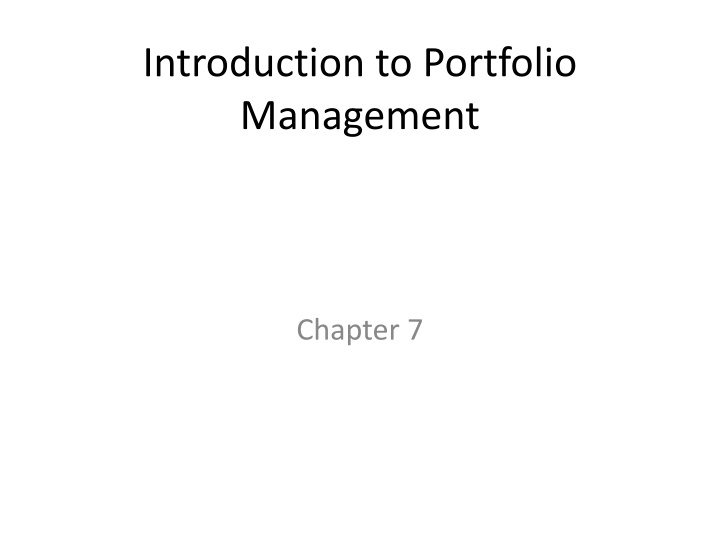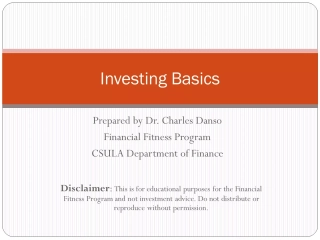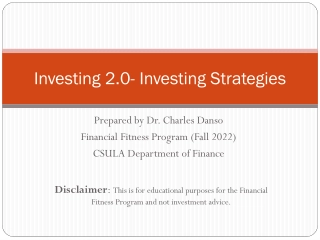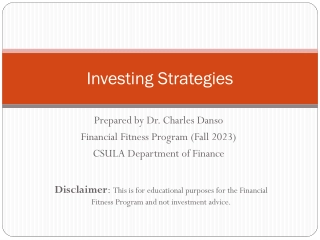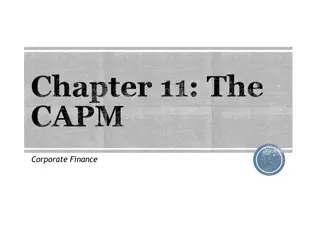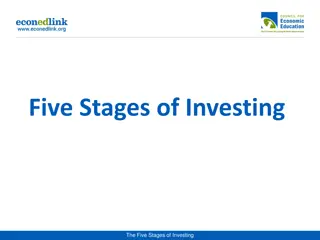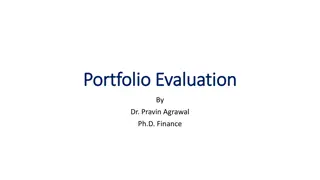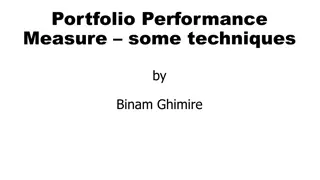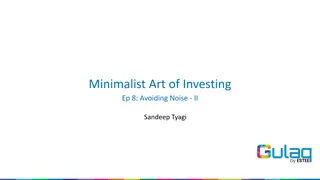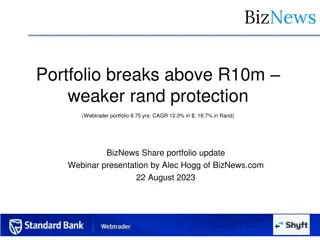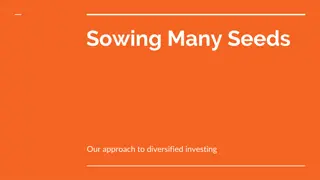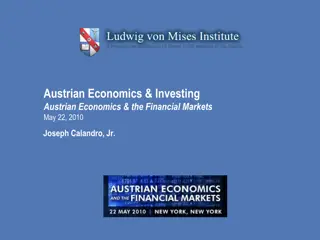Fundamentals of Portfolio Management and Risk Aversion in Investing
Portfolio theory is based on the principles of maximizing returns for a given risk level, considering all assets owned. Investors typically exhibit risk aversion, preferring lower risk assets for similar returns. Risk is defined as future outcome uncertainty. Markowitz Portfolio Theory highlights the importance of diversification to reduce overall portfolio risk.
Download Presentation

Please find below an Image/Link to download the presentation.
The content on the website is provided AS IS for your information and personal use only. It may not be sold, licensed, or shared on other websites without obtaining consent from the author.If you encounter any issues during the download, it is possible that the publisher has removed the file from their server.
You are allowed to download the files provided on this website for personal or commercial use, subject to the condition that they are used lawfully. All files are the property of their respective owners.
The content on the website is provided AS IS for your information and personal use only. It may not be sold, licensed, or shared on other websites without obtaining consent from the author.
E N D
Presentation Transcript
Introduction to Portfolio Management Chapter 7
SOME BACKGROUND ASSUMPTIONS One basic assumption of portfolio theory is that investors want to maximize the returns from the total set of investments for a given level of risk. To understand such an assumption requires certain ground rules. First, your portfolio should include all of your assets and liabilities, not only your marketable securities but also your car, house, and less marketable investments such as coins, stamps, art, antiques, and furniture. The full spectrum of investments must be considered because the returns from all these investments interact, and this relationship among the returns for assets in the portfolio is important. Hence, a good portfolio is not simply a collection of individually good investments.
Risk Aversion Portfolio theory also assumes that investors are basically risk averse, meaning that, given a choice between two assets with equal rates of return, they will select the asset with the lower level of risk. This does not imply that everybody is risk averse, or that investors are completely risk averse regarding all financial commitments. The fact is, not everybody buys insurance for everything. This combination of risk preference and risk aversion can be explained by an attitude toward risk that depends on the amount of money involved. While recognizing such attitudes, we assume that most investors with a large investment portfolio are risk averse. Therefore, we expect a positive relationship between expected return and expected risk
Definition of Risk Although there is a difference in the specific definitions of risk and uncertainty, for our purposes and in most financial literature the two terms are used interchangeably. For most investors, risk means the uncertainty of future outcomes. An alternative definition might be the probability of an adverse outcome. In our subsequent discussion of portfolio theory, we consider several measures of risk that are used when developing and applying the theory. Measures of risk what do you mean by this?
MARKOWITZ PORTFOLIO THEORY In the early 1960s, there was no specific measure for risk. The basic portfolio model was developed by Harry Markowitz (1952, 1959), who derived the expected rate of return for a portfolio of assets and an expected risk measure. Markowitz showed that the variance of the rate of return was a meaningful measure of portfolio risk under a reasonable set of assumptions. More important, he derived the formula for computing the variance of a portfolio. This portfolio variance formula not only indicated the importance of diversifying investments to reduce the total risk of a portfolio.
MARKOWITZ PORTFOLIO THEORY It also showed how to effectively diversify. The Markowitz model is based on several assumptions regarding investor behavior: 1. Investors consider each investment alternative as being represented by a probability distribution of expected returns over some holding period. 2. Investors maximize one-period expected utility, and their utility curves demonstrate diminishing marginal utility of wealth. 3. Investors estimate the risk of the portfolio on the basis of the variability of expected returns. 4. Investors base decisions solely on expected return and risk, so their utility curves are a function of expected return and the expected variance (or standard deviation) of returns only. 5. For a given risk level, investors prefer higher returns to lower returns. Similarly, for a given level of expected return, investors prefer less risk to more risk. Under these assumptions, a single asset or portfolio of assets is considered to be efficient if no other asset or portfolio of assets offers higher expected return with the same (or lower) risk or lower risk with the same (or higher) expected return.
Alternative Measures of Risk Variance, or standard deviation of expected returns. It is a statistical measure of the dispersion of returns around the expected value. The idea is that the more dispersed the expected returns, the greater the uncertainty of future returns. Another measure of risk is the range of returns. It is assumed that a larger range of expected returns, from the lowest to the highest, means greater uncertainty regarding future expected returns. Some observers believe that investors should be concerned only with returns below expectations, which means only deviations below the mean value. A measure that only considers deviations below the mean is the semivariance. An extension of the semivariance measure only computes expected returns below zero (that is, negative returns), or returns below the returns of some specific asset such as T-bills, the rate of inflation, or a benchmark. These measures of risk implicitly assume that investors want to minimize the damage (regret) from returns less than some target rate. Assuming that investors would welcome returns above some target rate, the returns above such a target rate are not considered when measuring risk.
Expected Rates of Return The expected return for an individual risky asset is the sum of the products of the set of potential returns and its corresponding probabilities. The expected rate of return for a portfolio of investments is simply the weighted average of the expected rates of return for the individual investments in the portfolio. The weights are the proportion of total value for the individual investment. where: wi = the weight of an individual asset in the portfolio, or the percent of the portfolio in Asset i Ri = the expected rate of return for Asset i
Variance (Standard Deviation) of Returns for an Individual Investment A measure of the variation of possible rates of return Ri from the expected rate of return E(Ri) as follows: where Pi is probability of the possible rate of return Ri How to compute expected return?
Covariance Covariance and Correlation starting point Covariance is a measure of the degree to which two variables move together relative to their individual mean values over time. In portfolio analysis, we usually are concerned with the covariance of rates of return rather than prices or some other variable. (Positive covariance vs Negative covariance) The magnitude of the covariance depends on the variances of the individual return series, as well as on the relationship b/w the series. The covariance statistic provides an absolute measure of how they moved together over time. For two assets, i and j, the covariance of rates of return as Note that when we apply formula to actual sample data, we use the sample mean as an estimate of the expected return and divide the values by (n - 1) rather than by n to avoid statistical bias
Covariance As can be seen, if the rates of returns are above (below) its mean rate of returns during a given period then the product of these deviations from the mean is positive. If this happens consistently, the covariance of returns between these two assets will be some large positive value. If, however, the rate of return for one of the securities is above (below) its mean return, while the return on the other security is below (above) its mean return, the product will be negative. If this contrary movement happens consistently, the covariance between the rates of return for the two assets will be a large negative value.
Covariance Interpretation of a number such as -5.06 is difficult; is it high or low for covariance? We know the relationship between the two assets is clearly negative, but it is not possible to be more specific.
Covariance and Correlation Covariance is affected by the variability of the two individual returns. Therefore, a number such as the -5.06 in our example might indicate a weak negative relationship if the two individual indexes were volatile, but would reflect a strong negative relationship if the two indexes were relatively stable. Obviously, we want to standardize this covariance measure. We do so by taking into consideration the variability of the two individual return indexes, as follows: Standardizing the covariance by the product of the individual standard deviations yields the correlation coefficient rij, which can vary only in the range -1 to +1.
SD of Portfolio Portfolio Standard Deviation Formula Now that we have discussed the concepts of covariance and correlation, we can consider the formula for computing the standard deviation of returns for a portfolio of assets, our measure of risk for a portfolio. In Exhibit 7.2, we showed that the expected rate of return of the portfolio was the weighted average of the expected returns for the individual assets in the portfolio; the weights were the percentage of value of the portfolio. One might assume it is possible to derive the standard deviation of the portfolio in the same manner, that is, by computing the weighted average of the standard deviations for the individual assets. This would be a mistake. Markowitz (1959) derived the general formula for the standard deviation of a portfolio as follows:
